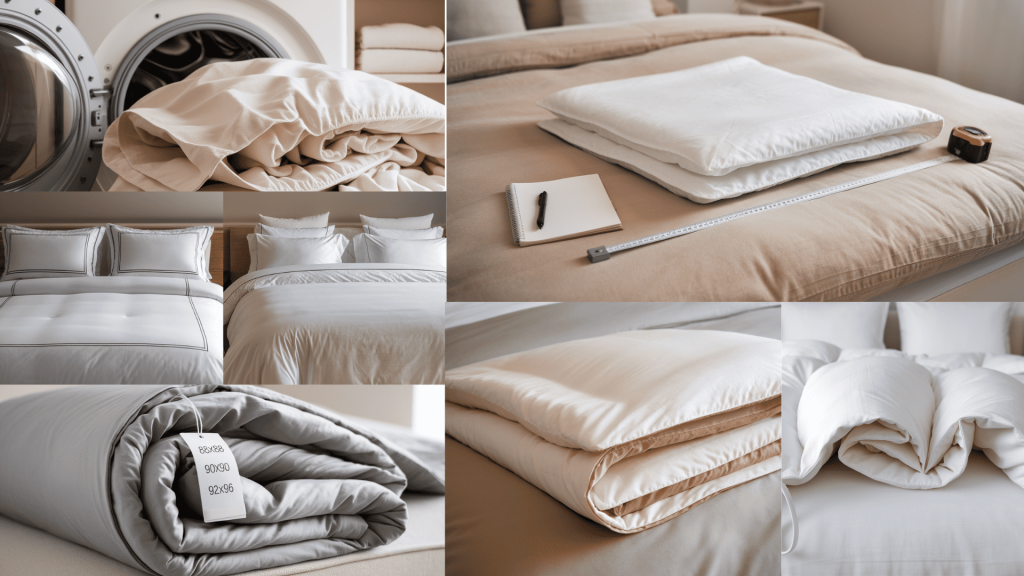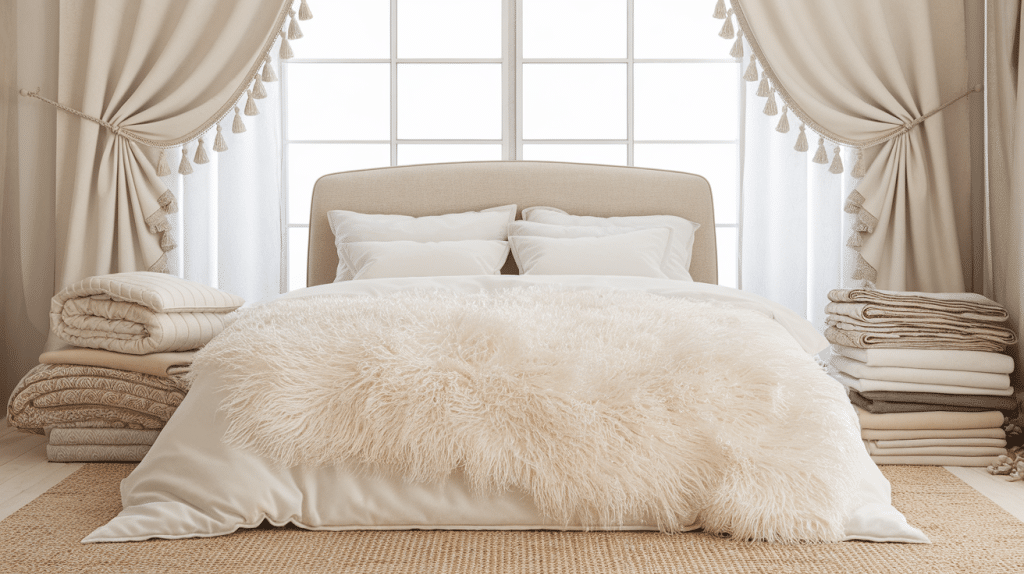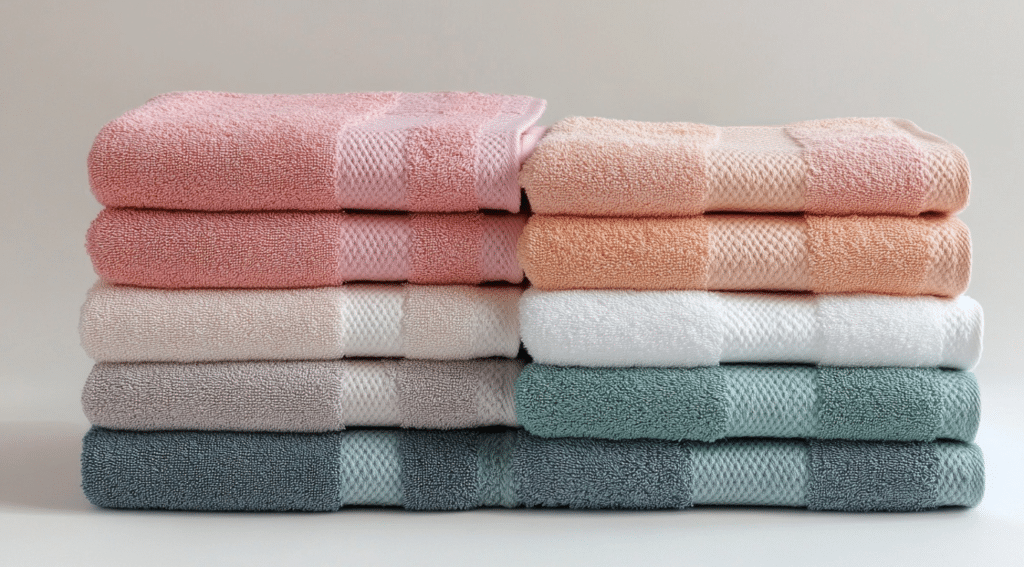Ever bring home a duvet that just didn’t fit right? Maybe it was too short, not wide enough, or didn’t drape like you pictured. I’ve had that happen more than once, and it’s frustrating.
Choosing the right bedding sounds simple, but figuring out what a queen duvet size actually means. That part gets tricky.
That’s why I put this guide together. You’ll find clear info on standard sizes, fabric types, inserts vs. covers, and the common sizing mistakes I’ve learned to avoid.
If you’re upgrading your space or buying your first set, you’ll walk away knowing how to get that perfect fit, something that feels just right and looks even better. Let’s start with the size you really need.
What is a Queen Duvet Size?
A queen duvet is that big, cozy blanket that’s made just for a queen-size bed. It usually runs about 88 to 90 inches on each side, so it’s got plenty of room to drape over the edges.
I’ve found that, unlike fitted sheets, which have to match your mattress perfectly, a duvet is meant to hang a bit, giving your bed a softer, fuller look.
It keeps you covered at night and makes your bed feel tidy and inviting during the day. Simple, comfy, and it just pulls the whole room together.
Standard Queen Duvet Dimensions
The most common queen duvet sizes you’ll encounter include:
- 90″ x 90″ – This square dimension is the most popular choice, offering ample coverage for standard queen beds (60″ x 80″) with plenty of overhang on all sides.
- 88″ x 90″ – Slightly narrower but equally long, this size works well for those who prefer less drape on the sides while maintaining full length coverage.
- 90″ x 95″ – Some brands offer this longer option, which is ideal for taller individuals or those who like extra coverage at the foot of the bed.
- 88″ x 88″ – A more compact square option that provides adequate coverage while working well in smaller bedrooms.
I’ve noticed that queen duvet sizes can vary a bit depending on the brand; some run a few inches bigger or smaller. That’s why it’s always a good idea to double-check the exact measurements before you buy.
What matters most is that your duvet gives you the coverage you need to stay comfortable at night and still looks great with the rest of your bedroom. A good fit really does make a difference.
How to Choose the Right Duvet Size?
Picking the right duvet size isn’t only about matching it to your mattress; it also depends on how thick your bed is and the look you’re going for.
If your mattress is on the taller side, you’ll probably want a larger duvet so it hangs just right. And your style plays a part too. Do you like everything neat and tucked in? Or do you prefer a softer, more draped look?
Thinking about both comfort and style will help you choose the size that actually works for you.
Mattress Thickness Matters
Your mattress height plays a big role in how your duvet fits and looks. I’ve definitely noticed this with my own setup. If you’ve got a standard mattress (around 8–12 inchesthick), most queen duvets fit just fine and hang the way they’re supposed to.
But if your mattress is thicker, 13 inches or more, or you’re using a plush mattress topper, you’ll want to think about sizing up. A thicker bed takes up more fabric, so your duvet won’t drape as nicely unless it’s a bit longer or wider. In that case, something like 90″ x 95″ can give you better coverage.
On the flip side, if you’ve got a thinner mattress (under 10 inches) or a low-profile platform bed, standard queen duvet sizes like 88″ x 90″ usually do the trick without feeling oversized. It’s all about finding that balance between comfort and appearance.
Snug Fit vs. Draped Look
Your style plays a big part in choosing the right duvet size. If you like a clean and simple look, go with a size closer to 88″ x 90″. It gives a neat fit with less fabric hanging off the sides, great for modern rooms or smaller spaces.
However, if you prefer a softer, fuller feel like you see in hotel rooms, opt for a size around 90″ x 90″ or larger. The extra fabric gives you more drape and flow, making your bed feel extra cozy and inviting.
Consider your bedroom size too – oversized duvets can overwhelm compact spaces, while smaller duvets might look insufficient on beds in large rooms.
Duvet Insert vs. Duvet Cover: What’s the Difference?
Knowing the difference between a duvet insert and a duvet cover makes setting up your bed a whole lot easier. I didn’t fully get it at first either.
They work together, but they serve totally different purposes. The insert is what gives you the warmth and comfort while you sleep.
The cover, on the other hand, is all about style and protection; it keeps the insert clean and lets you switch up your look whenever you want.
Once you get how each one works, it’s way easier to choose what fits your bed, your style, and how you like to live.
Here’s a simple breakdown to make it all clear:
| Feature | Duvet Insert | Duvet Cover |
|---|---|---|
| What it is | The fluffy comforter inside your bedding | A removable fabric case that wraps around the insert |
| Main Purpose | Provides warmth and comfort | Adds style and protects the insert |
| Washability | Needs a large washer and dryer | Easy to wash in a regular machine |
| Durability | Lasts for years with proper care | Swapped more often for style changes |
| Style Flexibility | Meant to stay hidden | Easy to change for a new look anytime |
Together, the duvet insert and cover create a cozy, stylish setup, each doing its part to keep you warm and your bed looking great.
Finding the Perfect Duvet Insert
Pairing your duvet insert with the right cover is important, but it’s not always super easy.
Here’s what to remember: if you take a little time to get it right, your bed will feel comfy and look neat. No lumps, no empty corners, just the cozy setup you want.
1. Size Match Matters
Try to get an insert that’s the same size as your cover, or just a little bigger. A 90″ x 90″ insert fits great in a 90″ x 90″ cover.
You can even use a 92″ x 92″ insert for a fluffier look. Just don’t go smaller. An 88″ x 88″ insert in a 90″ cover will leave flat, empty corners.
2. How Puffy Do You Want It?
Some inserts are thick and fluffy (like those filled with high-quality down), while others are thinner and smoother (like down-alternative or lower-fill options).
If your cover has a bold or fancy design, a puffier insert helps show it off better.
3. Think About the Seasons
I’ve found that using a lighter duvet insert in the summer and switching to a heavier one in the winter makes a big difference in how comfortable you feel year-round. You might even want to keep two or three inserts on hand and just rotate them with the seasons.
The great part? You can use the same duvet cover, so your bed still looks the same, no need to change up your whole setup. It’s a simple way to stay cozy without dealing with extra laundry or constantly restyling your bedding.
4. Spend Smart on the Insert
You’ll likely swap out your duvet cover way more often than the insert. I’ve definitely done that myself. That’s why it makes sense to invest in a quality insert that holds its shape and can last you five, even ten years.
Covers, on the other hand, are easier and cheaper to change when you’re ready for a new look or just want to refresh your space.
In the end, picking the right duvet insert is all about comfort, style, and getting the sizing right. When you find that perfect fit, you’ll sleep better, and your bed will look great day after day.
Queen Duvet Size and Fabric Types
The fabric you choose for your queen duvet makes a bigger difference than you might think. I’ve noticed that some materials help you stay cool, while others keep you warm, and each one has its own feel against your skin.
If you pick the right fabric, bedtime gets a whole lot cozier. But if it’s not a good match for how you sleep, it can leave you tossing and turning. It’s all about finding what feels right for you.
| Fabric Type | Pros | Cons | Best For |
|---|---|---|---|
| Cotton | Soft, breathable, durable, and suitable for all seasons | May shrink, wrinkle, and feel rough if of low quality | Year-round comfort, everyday use |
| Linen | Very breathable, cool, softens over time | Wrinkles easily, rough at first, not warm for winter | Hot sleepers, summer, relaxed, or boho styles |
| Flannel | Warm, soft, cozy, and affordable | Too hot for some, can pill, not great year-round | Cold sleepers, winter, extra cozy feel |
| Organic Cotton | Chemical-free, soft, breathable, eco-friendly | Costs more, fewer options, harder to find | Sensitive skin, natural living, and eco-conscious shoppers |
For year-round comfort, pick your duvet fabric based on how you sleep and your climate. If you sleep hot, go with linen or lightweight cotton. If you run cold, try a flannel or thicker cotton.
Some people use one duvet for summer and another for winter. Just choose what feels best for your body and routine.
How to Measure a Duvet Cover for a Perfect Fit

Getting the right size duvet makes your bed look neat and feel just right. A good fit keeps things from shifting or bunching up. Take a little time to measure; it makes a big difference.
Here’s a quick list of what you’ll need:
- Measuring tape
- Pen or pencil
- Paper to write down measurements
- A helper (optional, but makes measuring easier)
Getting the perfect duvet fit is easier when you follow a few simple steps. Here’s how to do it right from the start:
Step 1: Measure Your Current Duvet Insert. Lay the insert flat and measure width edge-to-edge, then length top-to-bottom, recording exact dimensions rather than relying on manufacturer labels.
Step 2: Choose Your Fit Preference. Select cover dimensions that match your insert exactly for a tailored look, or add 2-4 inches for a fuller appearance.
Step 3: Verify Cover Dimensions. Check actual interior measurements before purchasing, as “queen” sizes can vary from 88″ x 88″ to 92″ x 96″.
Step 4: Account for Shrinkage. Add 1-2 inches to your target cover size when choosing natural fibers that may shrink after washing.
Step 5: Test the Fit. Insert your duvet and ensure it fills corners completely without bunching while closing easily without forcing.
Step 6: Adjust if Necessary. Use corner ties for oversized covers or exchange for larger sizes if the fit is too tight.
With a little planning and the right tools, you’ll end up with bedding that looks great, feels comfy, and fits just the way you like it.
Chart of Queen Duvet Size
Having a simple size chart makes it way easier to see how queen duvets stack up against other sizes. It helps you pick the right one for your bed without all the guessing.
Here’s a quick look at the sizes in both inches and centimeters, so you can compare quickly, no matter what you’re used to:
| Bed Size | Duvet Dimensions (Inches) | Duvet Dimensions (Centimeters) | Mattress Size (Inches) |
|---|---|---|---|
| Twin | 68″ x 86″ | 173 cm x 218 cm | 38″ x 75″ |
| Full/Double | 80″ x 86″ | 203 cm x 218 cm | 54″ x 75″ |
| Queen | 88″ x 90″ | 224 cm x 229 cm | 60″ x 80″ |
| Queen (Oversized) | 90″ x 90″ | 229 cm x 229 cm | 60″ x 80″ |
| King | 102″ x 86″ | 259 cm x 218 cm | 76″ x 80″ |
Keeping these sizes in mind makes shopping easier and helps you avoid a duvet that’s too short, too long, or just not right.
Queen duvets come in a few size variations to suit different needs. The Standard Queen (88″ x 90″) is the most common, giving good coverage with a moderate overhang on all sides.
The Oversized Queen (90″ x 90″) has equal length and width, offering more side coverage and a fuller, draped look.
For taller sleepers or those who like extra coverage at the foot of the bed, the Extra Long Queen (90″ x 95″) adds extra length without changing the width.
Sizing Mistakes with Queen Duvets
Buying the right duvet size might seem simple, but it’s easy to mess up. I’ve been there too. A few small mistakes can leave you tossing and turning or staring at a bed that just looks off.
Here are the five biggest slip-ups people make and how you can steer clear of them.
1. Forgetting About Thick Mattresses
Most people only think about how long and wide their mattress is. But if you have a thick mattress or use a mattress topper, you need a bigger duvet to cover the sides properly.
A regular 88″ x 90″ duvet might look great on a thin mattress, but it will look too small on a thick one. The easy fix is to measure how tall your whole mattress setup is. If it’s really thick, get a duvet that’s 2-4 inches bigger than you think you need.
2. Buying Covers That Are Too Small
When people buy duvet covers that are exactly the same size as their duvet, it makes everything look flat and squished.
Tight covers also make it super hard to stuff your duvet inside and can rip the seams. Instead, buy covers that are 2-4 inches bigger than your duvet. This gives your bedding room to puff up and look nice while making it easier to put together.
3. Thinking All “Queen” Sizes Are the Same
Just because two duvets both say “queen” doesn’t mean they’re the same size. Different brands make different sizes – some might be 86″ x 86″ while others are 92″ x 96″.
Don’t just trust the label. Always check the exact measurements before you buy, and write down what works so you remember for next time.
4. Not Thinking About Shrinking
Cotton and linen duvets and covers can shrink when you wash them, even if the tag says they won’t. If you buy something that fits perfectly, it might be too small after you wash it for the first time.
To avoid this problem, buy things that are 1-2 inches bigger than what you think you need. Also, follow the washing directions exactly and try air-drying instead of using the dryer.
Conclusion
Now you’ve got a real handle on what a queen duvet size actually means and how to pick one that fits your bed just right. I’ve walked you through everything from measuring tips to fabric picks and a few mistakes I’ve learned to avoid along the way.
Take a minute to look at your own bed and think about what kind of duvet would give you the best mix of comfort and style. I’ve found that getting the size right can totally change how your bed looks and feels.
Before you head out to shop, make sure to double-check those measurements, because not every “queen” is exactly the same.
If this was helpful, you’ll probably enjoy some of the other simple guides I’ve put together on bedding, decor, and easy ways to make your space feel more like home.











